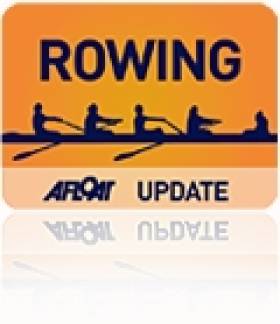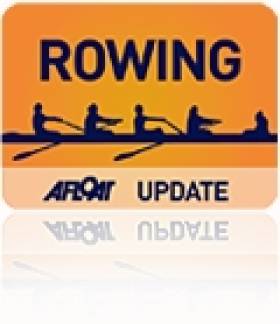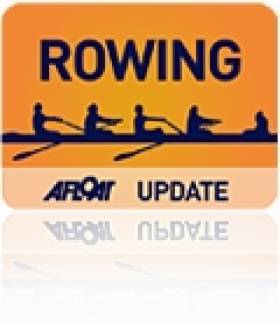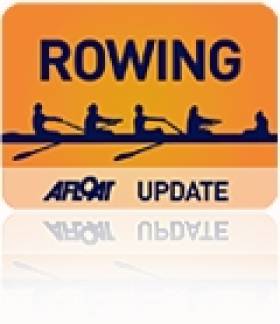Displaying items by tag: Dublin,
Good Day for Methody Rowers at Neptune Regatta
#ROWING: Methodist College, Belfast, won the men’s junior 18 eight and coxed four at Neptune Regatta. Two UCD crews fought it out in the final of the women’s senior coxed four, with UCD B coming out on top.
| 1 |
|---|
| NEPTUNE REGATTA 2012 |
| Results - FINALS Saturday 21st April |
| Race Event North Station South Station Winner Margin |
| 33 M J 18 4X- Neptune Carlow Carlow Easily |
| 43 W J 18 1 X Carrick-on-Shannon (Kelly) Carrick-on-Shannon (Van der Speck) Carrick-on-Shannon (Kelly) 2L |
| 58 M J 14 2X Carrick-on-Shannon Commercial Carrick-on-Shannon 1.5 L |
| 73 W N 4+ Commercial Bann R.C UCD B 4L |
| 76 W N 1X Garda B.C (O'Brien) DULBC (Crowe) Garda O'Brien dist. |
| 78 W J 14 4X+ Bann Athlone Bann 2 L |
| 82 M J 16 2X Neptune Cork Boat Club Neptune 2 L |
| 83 W J 15 2X Commercial RC Carrick on Shannon BC Commercial 3L |
| 88 M S 1X Commercial (Crowley) Carlow (Coughlan) Carlow (Coughlan) 1.5L |
| 94 M Novice 1X Waterford (Corrigan) DUBC (Rooney) DUBC (Rooney) 2L |
| 97 W J 16 2X Carrick-on-Shannon Neptune RC Neptune 5L |
| 99 M Inter 1 X St. Michael's (O' Connor) Neptune (Harwood) SMRC (O'Connor) 3L |
| 100 M Masters 4+ Commercial RC Waterford Boat Club Commercial 2 1/4 L |
| 101 M N 4x+ Neptune Commercial RC Neptune Easily |
| 106 M J 14 4X+ Bann Cork (A) Cork A 1.5 L |
| 109 W Nov 4X+ Methodist College Neptune Neptune 1 1/4 L |
| 110 M N 8 Commercial RC Neptune RC Neptune 5L |
| 111 W Inter I 4+ Winner Race 79 UCD Boat Club UCD 2 L |
| 112 W J 16 8 Methodist College RC Commercial RC Commercial 3/4 L |
| 113 M J 16 8 Neptune Methodist College (A) Neptune 2 L |
| 114 M J 16 1X Athlone (Hannon) Athlone (Egan) Athlone (Egan) 5 L |
| 115 M Inter 8 Carlow RC Bann RC Bann 4 L |
| 116 M Masters 8 Old Collegians Boat Club Commercial RC Commercial 1 L |
| 117 W J 18 4X- Neptune Athlone Boat Club Neptune Easily |
| 118 W J 14 2X Carlow RC (A) Carlow RC (B) Carlow A Easily |
| 119 M J18 8 Neptune Methody Methody 1 1/4 L |
| 120 M J18 1X Bann (Gordon) Waterford (Konan) Bann (Konan) 1 L |
| 121 M J 15 4X+ Commercial (B) Carlow (A) Commercial 3 L |
| 122 W N 8 UCD DULBC DULBC 2 1/2 L |
| 123 W S 4+ UCD B UCD Boat Club (A) UCD B 2 L |
| 124 W I 1X Garda Boat Club (Holden) Methodist College RC (Gregson) Methody (Gregson) 5 L |
| 125 W J 16 4X+ Neptune Commercial RC Commercial 4 L |
| 126 M N 4+ Dublin University Boat Club Neptune RC Scratch |
UCD Rowers Fastest at Dublin Head of the River
ROWING: UCD’s men’s senior eight clocked 10 minutes 29 seconds in excellent conditions to claim the title of fastest crew at the Dublin Head of the River. Trinity took the Diane Cook trophy for best overall club.
Dublin Head of the River 2012 – Selected Results
Overall: 1 UCD senior eight 10 minutes 29 seconds, 2 St Michael’s sen eight 10:35, 3 Neptune, Carlow, Offaly sen eight 10:44, 4 Trinity intermediate eight 10:48, 5 UCD inter eight 11:00, 6 Trinity novice eight 11:05.
Pennants – Men, Eight – Senior: 1 UCD 10:29, 2 St Michael’s 10:35, 3 Neptune, Carlow, Offaly 10:44. Intermediate: 1 Trinity 10:48, 2 UCD 11:00, 3 Queen’s. Novice: 1 Trinity 11:05, 2 Queen’s 11:21, 3 Neptune 11:21. Junior: 1 Commercial 11:26, 2 Neptune 11:27, 3 Blackrock 12:29. Masters: 1 Commercial 11:24. Fours, coxed – Senior: Commercial 13:01.
Women, Eight – Senior: 1 St Michael’s, University of Limerick 12:05, 2 Queen’s 12:21, 3 UCD. Intermediate: 1 Trinity 12:14, 2 UCD 12:41, 3 Commercial 13:05. Novice/Junior: Shannon 13:29.
UCD Rowers Show Their True Colours
ROWING: UCD took three of the four titles on offer at a lively set of Colours Races in Dublin today. Trinity’s novice women denied the college a second consecutive clean sweep in perfect conditions.
In the men’s senior race, the Gannon Cup, Trinity took a surprise early lead. The bigger UCD eight reeled them in and as the crews passed the Four Courts, UCD had taken a lead they were not to lose. This gave Turlough Hughes of UCD a win over his twin brother Patrick, who rowed for Trinity.
The Corcoran Cup for senior women saw UCD lead all the way, though Trinity exerted serious pressure in the closing stages.
The two novice races were notable for different reasons. In the men’s race, UCD got off to an astounding start and won much as they liked. The women’s was the best contest of the day. Leaders UCD could not hold off the late surge of Trinity, who won by over a length.
Colours Races 2012
Senior Men (Gannon Cup): UCD bt Trinity 1l
Novice Men (Dan Quinn Shield): UCD bt Trinity distance
Senior Women (Corcoran Cup): UCD bt Trinity 1¼ l
Novice Women: Trinity bt UCD 1¼ l
Rowing Twins Take Each Other On in Gannon Cup
Twin brothers Turlough and Patrick Hughes (20) will vie for dominance in the Gannon Cup, the annual colours race between Trinity and UCD, on the Liffey on Bank Holiday Monday. UCD, who will be seeking their fifth consecutive Gannon, will be stroked by Turlough Hughes, while Patrick will be in the five seat in the Trinity boat. UCD’s Dave Neale will be seeking his fifth Gannon Cup title.
Trinity’s women’s eight, winner of two of the last three Corcoran Cups, have experience in their crew for Monday. Sinead Rodger and Keira Buttanshaw compete in their second Corcoran Cup; Susannah Cass her third and Caitlin Condon, an American, her fourth. UCD Ladies Boat Club have yet to announce their crew.
Mark Pollock, the adventurer who competed in the Gannon in 1995, 1996 and 1997 – and won all three - will be the guest of honour at the event. Pollock has shown tremendous fortitude in taking on blindness and then, separately, paralysis sustained in a fall.
Men’s Senior Eight (Gannon Cup)
UCD: Vincent Manning, Emmett Feeley, Simon Craven, Conor Walsh, Gearoid Duane, Dave Neale, Finbar Manning, Turlough Hughes; cox: Hannah Fenlon.
Trinity: P Mannix, AJ Rawlinson, Will Hurley, Charlie Landale, Patrick Hughes, Paul Flaherty, Ian Kelly, Danny Ryan; cox: Maeve Crockett.
Women’s Senior Eight (Corcoran Cup)
Trinity: Rebecca Dowling, Sinead Rodger, Keira Buttanshaw, Suzanne Daniels, Susannah Cass, Rebecca Deasy, Caitlin Condon, Ruth Morris; cox: Naomi O’Sullivan.
Monday’s Programme: 8:30 Sally Moorhead Trophy (Novice Women). 9:00 Dan Quinn Shield (Novice Men). 9:30 Corcoran Cup (Senior Women). 10:00 Gannon Cup (Senior Men)



























































